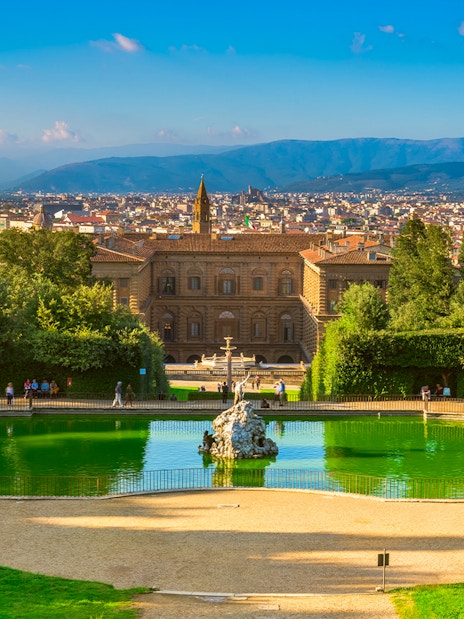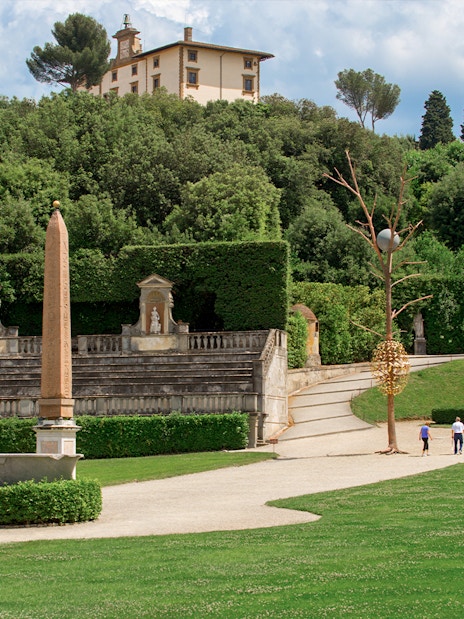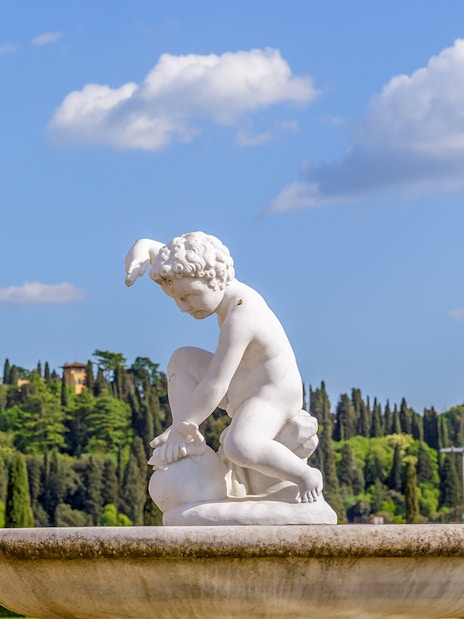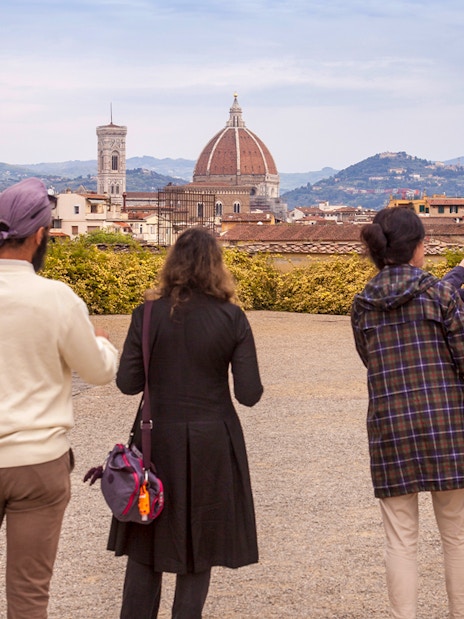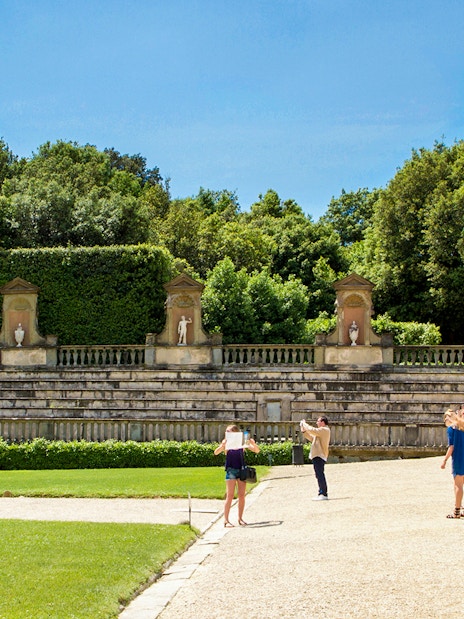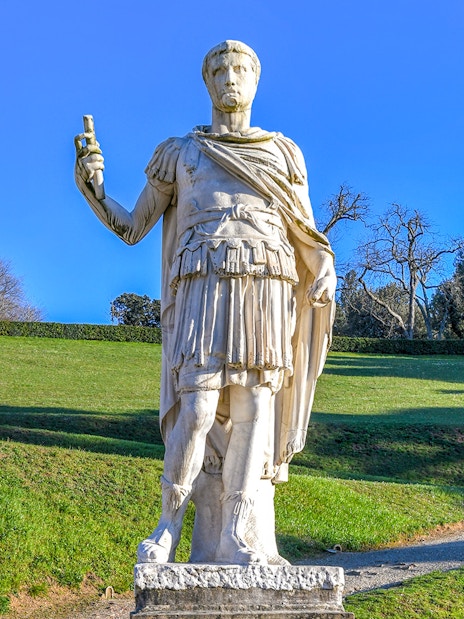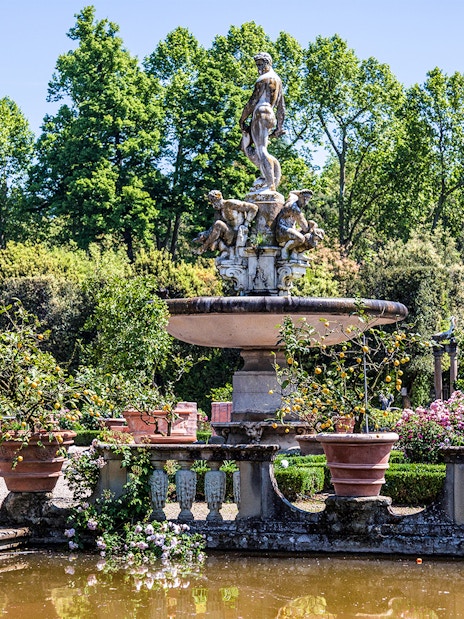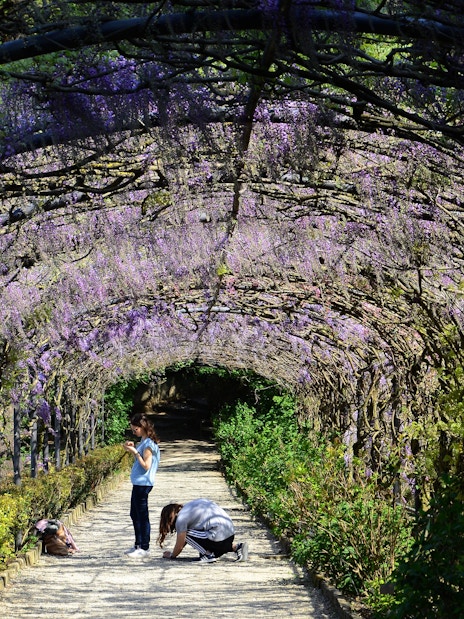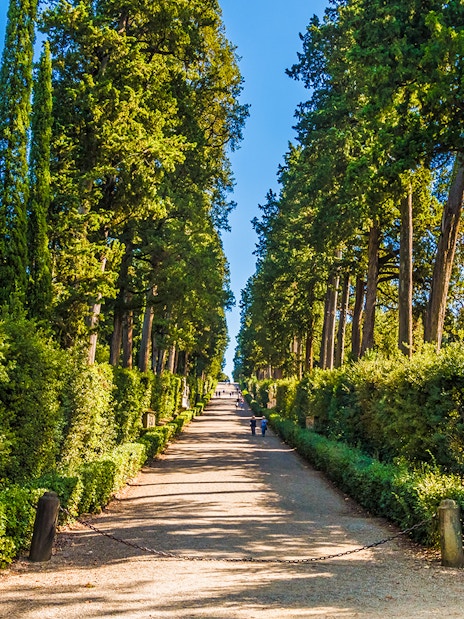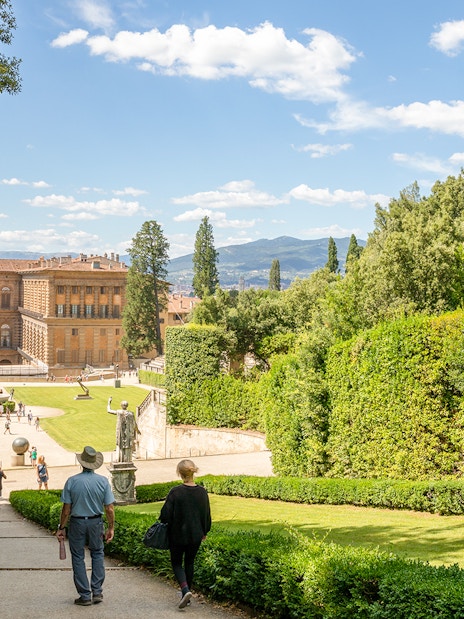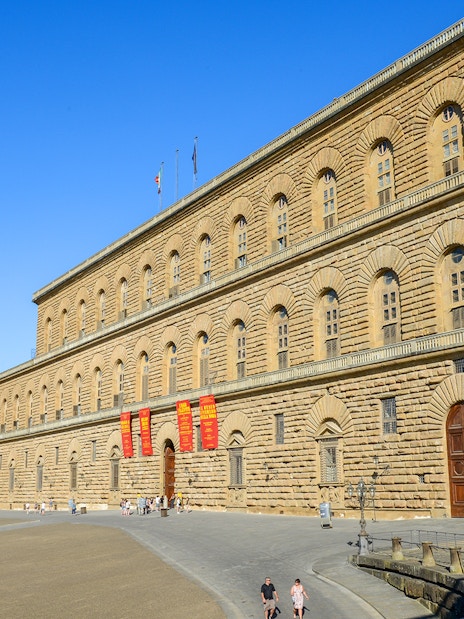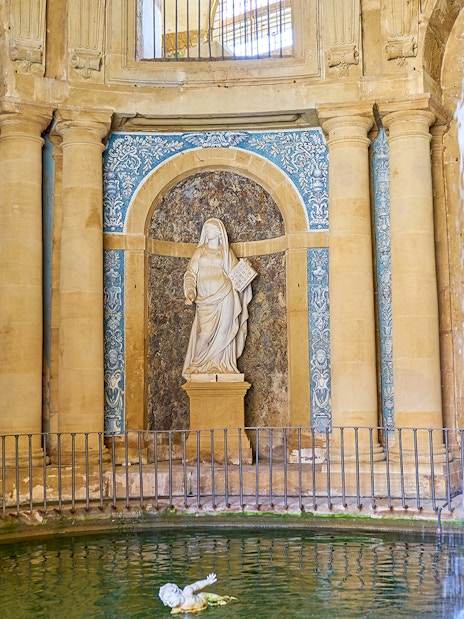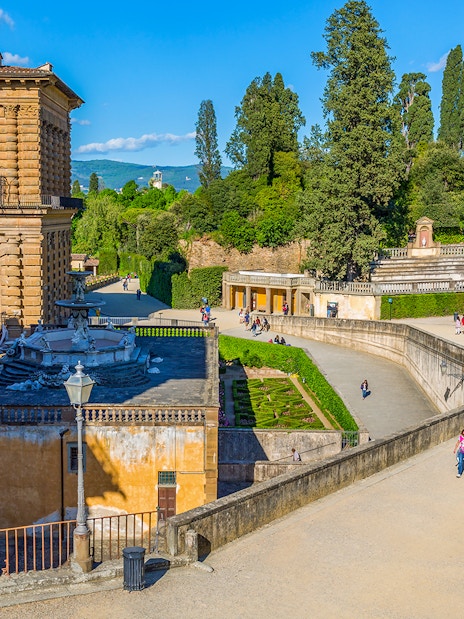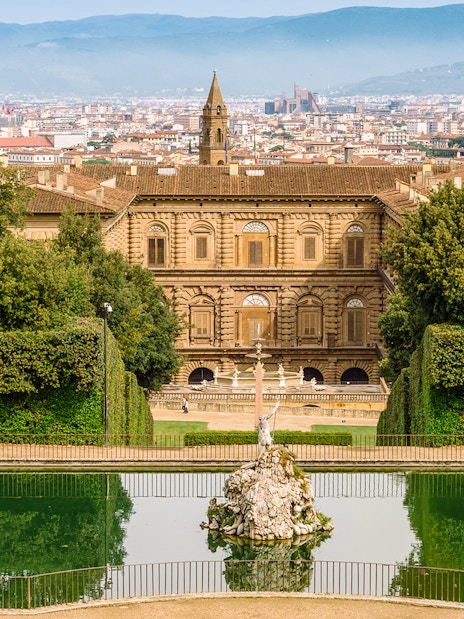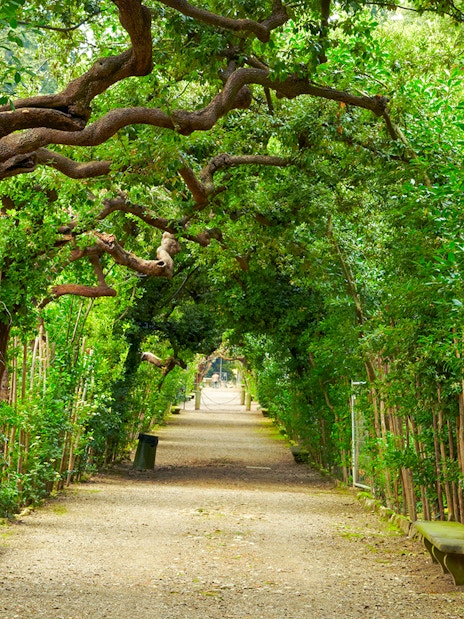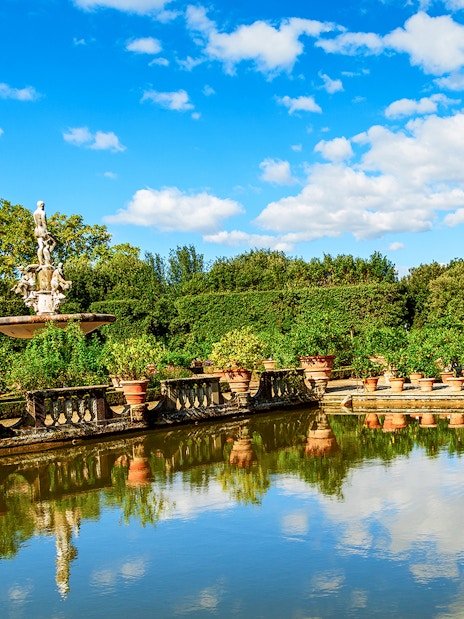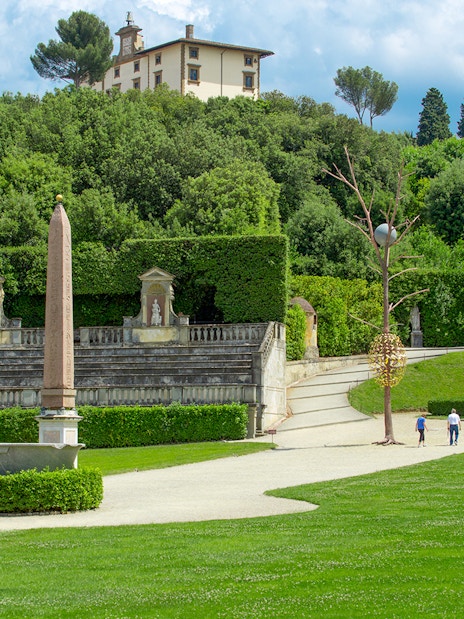- Uffizi Gallery
- Accademia Gallery Tickets
- Florence To Chianti Tours
- Duomo Florence
- Palazzo Vecchio
- Medici Chapel
- Florence To Cinque Terre Tours
- Bargello National Museum
- Florence To Pisa Tours
- Florence To Siena Tours
- Florence To Tuscany Tours
- Hzero - The Miniature Railway
- San Marco Museum
- Basilica of Santa Croce
Boboli Gardens Tours
Headout is an authorized and trusted partner of the venue, offering curated experiences to enjoy this attraction. This is not the venue's website.

Perfect for families, couples short on time and want to explore Boboli Gardens
- Think of that breathtaking Tuscan landscape with cypress-lined trees. That’s what you see at Boboli Gardens with a 1-hour guided tour.
- Don't let language get in the way! Choose from Spanish, Italian, or English, and enjoy spirited conversations with your guide.
- The Gardens stretch across an impressive 111 acres. You'll see Roman and Renaissance sculptures, and unique grottos, including the famous Buontalenti grotto.
- Pose your best at the many wonderful fountains, such as the Fountain of Neptune, Monkey Fountain, and the Fountain of the Ocean.
Perfect for families, couples short on time and want to explore Boboli Gardens
- Think of that breathtaking Tuscan landscape with cypress-lined trees. That’s what you see at Boboli Gardens with a 1-hour guided tour.
- Don't let language get in the way! Choose from Spanish, Italian, or English, and enjoy spirited conversations with your guide.
- The Gardens stretch across an impressive 111 acres. You'll see Roman and Renaissance sculptures, and unique grottos, including the famous Buontalenti grotto.
- Pose your best at the many wonderful fountains, such as the Fountain of Neptune, Monkey Fountain, and the Fountain of the Ocean.
Inclusions
- 1-hour guided tour of Boboli Gardens
- Entry to Boboli Gardens
- Italian/Spanish/English-speaking guide (as per option selected)
- Entry to Bardini Gardens
Exclusions
- Guided tour of Pitti Palace, Bardini Gardens and Ceramic Museum
- Tip: Comfortable yet elegant attire will keep you in step with the garden’s timeless charm. Think Florence meets romance on film.
- The entire Boboli Gardens area is pedestrianized, and is not accessible by vehicle; if you have a disability badge, you can park nearby.
- You can cancel these tickets up to 48 hours before the experience begins and get a full refund.
- Skip the lines and delve into the Pitti Palace, Palatine Gallery and Boboli Gardens with a passionate guide, unlocking Renaissance secrets.
- Walk in the footsteps of the Medici, Florence's most powerful family, with exclusive access to their grand residence, the Pitti Palace.
- See iconic works by Raphael, Pietro Perugino, and Riminaldi, housed in the opulent Palatine Gallery, alongside captivating frescoes.
- Escape the crowds on a stroll through the Boboli Gardens, once a playground of Medici nobles. Be sure to look for hidden grottos!
- A small group tour means personalized attention and ample time to ask questions, ensuring an enriching and interactive experience.
- Skip the lines and delve into the Pitti Palace, Palatine Gallery and Boboli Gardens with a passionate guide, unlocking Renaissance secrets.
- Walk in the footsteps of the Medici, Florence's most powerful family, with exclusive access to their grand residence, the Pitti Palace.
- See iconic works by Raphael, Pietro Perugino, and Riminaldi, housed in the opulent Palatine Gallery, alongside captivating frescoes.
- Escape the crowds on a stroll through the Boboli Gardens, once a playground of Medici nobles. Be sure to look for hidden grottos!
- A small group tour means personalized attention and ample time to ask questions, ensuring an enriching and interactive experience.
Inclusions
- Guided tour of Pitti Palace, Palatine Gallery & Boboli Gardens with entry
- Expert English-speaking guide
- Headsets for groups of 3+
- Tip: Head to Piazzale Michelangelo, a short walk from Pitti Palace, for panoramic views of Florence bathed in the golden hues of the setting sun.
- Safety is a priority so this experience is restricted for guests under the age of 5 years and over the age of 80 years.
- Nobody likes a crowd. A single group has a maximum of 12 people.
- Keep in mind food & beverages are not allowed in the exhibition areas.
- Mobile phones must be turned off or at least placed in silent mode.
- It is forbidden to run or walk barefoot in the museum premises.
- Shutterbugs, take note: Photography with any professional equipment including the use of flash and drones is a no-go inside the venue.
- Pets cannot tag along for this experience, with the exception of guide dogs and service animals, properly leashed and with a public medical certificate.
- From the square, the slope to the entrance of the Pitti Palace is rather steep (with a maximum gradient of 20%), so a companion is recommended for wheelchair users.
- From the courtyard, you can take the stairs or lifts to access the Palatine Gallery (1st floor). The lifts are located on the right side near the cloakroom.
- The entire Boboli Gardens area is pedestrianized, and is not accessible by vehicle; if you have a disability badge, you can park nearby.
- Facilities: free cloakroom storage.
- Backpacks, bags, umbrellas and other large objects must be stored in the cloakroom prior to entry.
- You can cancel these tickets up to 48 hours before the experience begins and get a full refund.
Reviews
How do we collect reviews?
Snapshots from our guests
4.9
16 ratings
14
2
0
0
0
What our guests say
Wendy
Jun 2025Verified booking
The Pitti Palace art collection the Fashion in History gallery and the magnificent palace itself were amazing. Our guide was extremely knowledgeable and made the whole tour wonderful.
Steven
Apr 2025Verified booking
Camilla, our guide was engaging, energetic and had boundless knowledge of the Palace and gardens. She tailored her presentation to the specific group of tourists. We had a wonderful experience with her and learned a great deal.
christine
May 2025Verified booking
Amazing tour witha wonderful guide. Not overwhelming - purely inteesting and key pieces of art were explained.
Valerie
Apr 2025Verified booking
Our guide Camilla brought the history to life and we enjoyed every minute of it.
liliane
Jun 2025Verified booking
Thea
May 2025Verified booking
EMILIO
May 2025Verified booking
Rhonda
Apr 2025Verified booking
Timothy
Apr 2025Verified booking
chefneux
Mar 2025Verified booking
Leticia
Oct 2024Verified booking
The experience, knowledge and kindness of our guide. Also the punctuality and the knowledge to lead the group.
View original review in Spanish
Robyn
Oct 2024Verified booking
David
Sep 2024Verified booking
The tour guide was very knowledgeable and engaging. The entire process was easy, seamless.
Susan
Jun 2024Verified booking
We learnt so much about Florence history and it's people through our guide and the portraits throughout the palace. Such a beautiful gem! The gardens are magnificent and a pleasure to walk through on a hot day. Highly recommend!
Alain
Jun 2024Verified booking
Stacy
Apr 2024Verified booking
Combos
Combo (Save 10%): Uffizi Gallery & Vasari Corridor Ticket + Pitti Palace, Boboli & Bardini Gardens Skip-the-Line Ticket
from €93.90
€84.23
10% off
All-in-one Florence experience with Uffizi, Vasari Corridor, Pitti Palace & Boboli Gardens.
- Save on time and money with this combo ticket that includes the Uffizi Gallery, Vasari Corridor, Pitti Palace, and Boboli Gardens.
- Discover iconic Renaissance art at the Uffizi and explore the Medici family’s secret passageway in the Vasari Corridor.
- Experience the grandeur of the Pitti Palace’s Royal Apartments with skip-the-line tickets before moving on to the Palatine Gallery and Porcelain Museum.
- Unwind at the Boboli and Bardini Gardens, admiring fountains, grottoes, and centuries-old artifacts.
All-in-one Florence experience with Uffizi, Vasari Corridor, Pitti Palace & Boboli Gardens.
- Save on time and money with this combo ticket that includes the Uffizi Gallery, Vasari Corridor, Pitti Palace, and Boboli Gardens.
- Discover iconic Renaissance art at the Uffizi and explore the Medici family’s secret passageway in the Vasari Corridor.
- Experience the grandeur of the Pitti Palace’s Royal Apartments with skip-the-line tickets before moving on to the Palatine Gallery and Porcelain Museum.
- Unwind at the Boboli and Bardini Gardens, admiring fountains, grottoes, and centuries-old artifacts.
Inclusions
Uffizi Gallery & Vasari Corridor
- Access to the Vasari Corridor
- Entry to Uffizi Gallery
Pitti Palace & Boboli Gardens
- Skip-the-line entry to Pitti Palace
- Skip-the-line entry to Boboli Gardens
- Access to Palatine Gallery
- Access to Bardini Gardens
- Access to Porcelain Museum
Exclusions
Uffizi Gallery & Vasari Corridor
- Guided tour of Ufizzi Gallery and the Vasari Corridor
Pitti Palace & Boboli Gardens
- Guide
- Transfers
- Access to the Grotta del Buontalenti at Boboli Gardens
Uffizi Gallery & Vasari Corridor
- Keep in mind large bags and suitcases are not allowed on this experience. Pack wisely!
- This experience is accessible for people with reduced mobility.
- Your tickets are nominative and cannot be transferred. The name and date of birth on the ticket must match the ID of the visitor.
- Note: The time slot you select is for the Uffizi Gallery. You must arrive at the Vasari Corridor two hours later. Please note that re-entry to the Uffizi Gallery is not permitted once you proceed to the corridor.
- Your ticket grants access to the Uffizi Gallery’s Statues and Paintings section, but visit it before your Vasari Corridor entry time, as it is a one-way route.
- Once you exit the Corridor at the Buontalenti Grotto, you cannot return to the Corridor.
Pitti Palace & Boboli Gardens
- Keep in mind food & beverages are not allowed in the exhibition areas.
- Mobile phones must be turned off or at least placed in silent mode.
- It is forbidden to run or walk barefoot in the museum premises.
- Shutterbugs, take note: Photography with any professional equipment including the use of flash and drones is a no-go inside the venue.
- Pets cannot tag along for this experience, with the exception of guide dogs and service animals, properly leashed and with a public medical certificate.
- From the square, the slope to the entrance of the Pitti Palace is rather steep (with a maximum gradient of 20%), so a companion is recommended for wheelchair users.
- From the courtyard, you can take the stairs or lifts to access the Palatine Gallery (1st floor). The lifts are located on the right side near the cloakroom.
- The entire Boboli Gardens area is pedestrianized, and is not accessible by vehicle; if you have a disability badge, you can park nearby.
- Facilities: free cloakroom storage.
- Backpacks, bags, umbrellas and other large objects must be stored in the cloakroom prior to entry.
- Guests under the age of 12 years must be accompanied by an adult.
- These tickets can't be cancelled or rescheduled.
Reviews
How do we collect reviews?
Snapshots from our guests
4.4
508 ratings
288
167
24
18
11
What our guests say
Brian
May 2025Verified booking
Artworks were overwhelming Rooms were opulent Spent several hours roaming The gardens were fresh and blooming
Antonio
Apr 2025Verified booking
The works of art in the Palace
View original review in Spanish
Mrs
Jun 2025Verified booking
The instructions were clear and easy to pick up the tickets and we were able to get about the place without any hold ups or delays.
Lucia
Jun 2025Verified booking
When I picked up my ticket, I was not warned at any point that it was not valid for the visit to the royal apartments. To see this, we had to return to the ticket office to pick up a ticket specifically for it (despite it being free access). Very poorly specified.
View original review in Spanish
Melinda
Jun 2025Verified booking
No issues at ticket office redeeming our voucher and transaction was easy. The pitti place and Gardens are both amazing and well worth the visit
Karel
Jun 2025Verified booking
WE LIKED: UFFIZI GALLERY WE DIDN'T LIKE: VASARI CORIDOR - after reconstruction only empty white wall space (overpass) with no arts at the time. Sculptures/busta in Coridor wraped in plastic - prepared for upcoming exhibition been said. PITTI PALACE - inside exhibitions - other disappointment - presentation of art stucked in the past - all of beautiful crystal chandeliers and statues covered by visible layer of dust/dirt... We have to say that we like art - we visited many museums and palaces around the Europe but never saw anything like that... It is pity that we cannot upload any photos to our review :(
Dmitry
Jun 2025Verified booking
Smooth e perience and easy purchasing process. The only drawback is a requirement to exchange booking reference for tickets at the ticket office.
MR
May 2025Verified booking
Our favourite visit in Florence. Great to skip the queues & spend more time discovering this beautiful palace & its gardens.
Vasilachi
May 2025Verified booking
There are no skip the line tickets. You have to go to the office to get your physical tickets anyway and then you have to wait in line.
Maria
Jun 2025Verified booking
Everything went very well, the tickets arrived promptly.
View original review in Spanish
Laura
Jun 2025Verified booking
Super fast entry, easy to use app, clear information. Overall great experience :)
View original review in Spanish
Gregory
Jun 2025Verified booking
Egyptian Obelisk Very helpful staff
E
Jun 2025Verified booking
They did not have WiFi at Pitti so I had to turn on my own internet which costs extra so I was annoyed about that
Carlier
Jun 2025Verified booking
A visit to the Palazzo Piti and the Palatine Gallery is a pure marvel. As for the garden, disappointingly uninteresting.
View original review in French
David
May 2025Verified booking
Thought the palace and gardens were fantastic. Tour with students added a special touch!
Laraine
May 2025Verified booking
The corridor has been beautifully restored but wasn't quite complete when I visited in May.
Julie
May 2025Verified booking
Ticketing was easy. The palace and gardens are beautiful, just as expected.
Jennifer
May 2025Verified booking
Easy and such an amazing place to visit. Incredible value. The cafe was wonderful as well.
Daniela
May 2025Verified booking
Easy tickets check in. Took advantage of the luggage store inside the palace before departure from the city.
Maria
May 2025Verified booking
well-kept environments, friendly and knowledgeable staff
View original review in Italian
Pamela
May 2025Verified booking
Everything was beautiful. So much history & well kept
Nicolae
Apr 2025Verified booking
Wonderful place and complete with everything. Perfect even for non-art enthusiasts.
View original review in Italian
Chrsitne
Apr 2025Verified booking
Great organization by the agency. Quick admission. Palazzo and gardens are an EXPERIENCE!
View original review in German
Kimberly
Jul 2025Verified booking
Andrej
Jun 2025Verified booking
Boboli Gardens Guided Tours
Make the most of Florence
Why take Boboli Gardens tours?

- Expert guidance: Tours offer the expertise of seasoned guides who intimately understand the garden's historical significance and artistic marvels, enriching your exploration.
- Save time: Guided tours streamline your experience, saving tons of time at the entrance and inside the attraction with priority access.
- Contextual narratives: Learn the fascinating stories behind every archway, extended area, sculpture and fountain, elevating the whole experience.
- Tour in your language: You can get guided tours to Boboli Gardens in your language.
Highlights covered on a Boboli Gardens tour
















See all photos
Frequently asked questions about Boboli Gardens tours
How much does a Boboli Gardens tour cost?
The pricing of the Boboli Gardens tours and tickets might vary depending on the type of experience you're choosing. Boboli Gardens guided tours starts from €49.
What is the best Boboli Gardens tour?
One of the popular choices is - Pitti Palace, Palatine Gallery & Boboli Gardens Guided Tour, starting at €98. Save time and delve into Renaissance secrets with a knowledgeable guide. Discover the grand Pitti Palace, admire famous artworks in the Palatine Gallery, and stroll through the tranquil Boboli Gardens, uncovering hidden grottos as you go.
Why should I opt for a guided tour of the Boboli Gardens, and what does it include?
Opting for a guided tour of the beautiful Boboli Gardens offers several benefits, including expert insights and historical context, making your visit more enriching and enjoyable. A typical guided tour includes a 1.5-hour stroll through the gardens, highlighting the beautiful statues, grottoes, and other notable features while learning about their history. Tours typically include fast-track entrance tickets, ensuring priority access and a more immersive journey through the gardens.
What is the cost of the Boboli gardens guided tour compared to a regular ticket?
The cost of a Boboli Gardens guided tour is typically more expensive than a regular ticket, reflecting the added value of expert commentary and insights. Guided tours can range from €15 to €20 more than regular tickets, but they also offer skip-the-line access, allowing visitors to bypass the crowds and enjoy a more immersive experience.
How long does a Boboli Gardens guided tour last?
The duration of a Boboli Gardens tour might vary depending on what it covers. A typical Boboli Gardens guided tour lasts two hours, since it also covers Pitti Palace and Palatine Gallery.
What languages are Boboli Gardens guided tours available in?
Boboli Gardens guided tours are available in several languages like English, Spanish, Italian, etc.
What parts of the Boboli Gardens can I access with a guided tour?
The tour typically covers highlights such as historic landscapes, sculptures by renowned artists, Palazzo Pitti, various fountains, and unique garden sections like Grotta Grande, Porcelain Museum and Bardini Garden.
Do I get skip-the-line access with my Boboli Gardens tour?
Yes, you can get skip-the-line access with the Boboli Gardens guided tour.
What is the cancellation policy for a Boboli Gardens tour?
You can cancel your Boboli Gardens tour tickets up to 24 hours before the tour begins.
Are the Boboli Gardens tours suitable for children?
Yes, Boboli Gardens tours are suitable for children. The perfect amalgam of nature, art, and artistry, Boboli Gardens beholds and inspires young minds.
Are there any physical requirements for the tour?
While the tour involves walking, it is generally suitable for most fitness levels. However, some areas might have uneven paths, so comfortable footwear is recommended. Those areas may be challenging for individuals with mobility issues or health conditions, but accommodations can be made on a case-by-case basis. There are provisions like rental wheelchairs and walkers available for assistance.
Can I book a private tour?
Unfortunately, we don't have a Boboli Gardens private tour yet. Although, our Boboli Gardens tour are small-group with a cap of 12 people.
How many people can go on a Boboli Gardens tour?
The number of people who can go on a Boboli Gardens tour can vary depending on the tour you're choosing. Our usual tours have a maximum capacity of 12 people.
Are audio guides available as an alternative to a human guide?
Sadly, we don't have audio guides are available as an alternative to a human guide for Boboli Gardens.
Are there any areas of the landmark/attraction within Boboli Gardens are accessible only with a guided tour?
There are no specific areas within the Boboli Gardens that are only accessible with a guided tour. The gardens are open to the public, and visitors can explore them independently or with a guided tour.
Is there a meet-up point for the tours, and where is it located?
There is a meet-up point for guided tours, which is typically at the entrance of the Boboli Gardens, particularly the Pitti Palace entrance, since the tours also cover Pitti Palace and Palatine Gallery.
What happens if I am late?
If you are late for a guided tour, you will have to skip the tour. You can try speaking to the provider if the window is small, say 5-10 minutes. Otherwise, you may need to reschedule your tour or explore the gardens independently.

